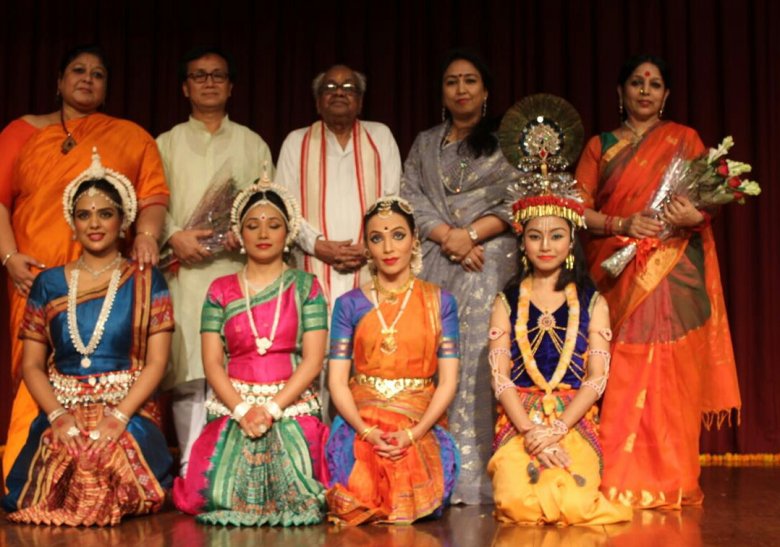
|   |

|   |
Celebrating Nritya Parampara - Ashwarya Samkaria e-mail: 23.ashwarya@gmail.com July 17, 2017 Sanchari bhava can be understood as the creative process of delving deep. Just as sunlight opens up the flower in the morning, sanchari bhava is that sunshine which opens up the main bhava being presented through the imaginative interpretation of words. The first guru to introduce the sanchari bhava to Odissi dance was none other than Guru Mayadhar Raut. What sanchari bhava is to Odissi, Guru Mayadhar Raut is to the Odissi dance fraternity. His artistic vision, creative imagination and shastra-based knowledge has culled out the essence of Odissi and brought to the audience, a dance that is graceful, sculpturesque and magnificent.  To celebrate the 87th birthday of Guru Mayadhar Raut, his daughter and disciple Madhumita Raut curated Nritya Parampara, a three day dance festival of Indian classical and contemporary dances. Inaugurated by Mridula Pradhan, the festival (6th to 8th July 2017) at Triveni Kala Sangam, New Delhi, brought to the stage twelve dancers who showcased Bharatanatyam, Chhau, Contemporary Dance, Kuchipudi, Manipuri, and Odissi performances. Staged with the aim of promoting the young talent, the festival saw a packed house and was a big success. Day one (6th July) of Nritya Parampara began with the graceful Manipuri dancer Chetna Wahengbam (disciple of Kamaljeet Wahengbam) who performed the lyrical Ras Leela Krishna Abhisar. Odissi dancer Jayanti Sarmah (disciple of Madhumita Raut) performed Lalita Lavanga Lata, a poem written by the 13th century poet Jayadeva and composed by Guru Mayadhar Raut that had his quintessential elements of lasya and intense abhinaya. Bharatanatyam dancer Nitya Balasubramanian (disciple of Jayalakshmi Eshwar) with her chaste lines and subtle abhinaya performed a Devi Mangalam, a song in praise of the three divine goddesses - Saraswati, Lakshmi and Durga and a Tillana, both choreographed by her guru. The first day of Nritya Parampara was brought to a graceful close by the Odissi dancer Sonam Samal (disciple of Madhumita Raut) as she performed her Guru’s composition Mahishasura Mardini Stotram on Devi or Shakti who is worshipped as the primordial cosmic energy and represents the dynamic forces that move through the entire universe. Day two (7th July) witnessed Odissi, Kuchipudi and Chhau dances. The chief guest was Priya Hingorani, Advocate, Supreme Court, Vice-President, Bar Association of India. The rasikas of Delhi danced as Odissi dancer, Dr. Priyanka Venkateshwaran (disciple of Madhumita Raut) performed Nachanti Krishna, a masterpiece choreographed by Guru Mayadhar Raut. Kuchipudi dancer Babita Phukan (Disciple of Meenu Thakur) performed a Jathiswaram and Bhamakalapam. In Bhama Pravesha dharu, Babita essayed the role of the protagonist, Satyabhama. The third performance of the evening was by Odissi dancer Aadya Kaktikar (disciple of Guru Mayadhar Raut and Madhumita Raut) who brought to the stage Guru Mayadhar Raut’s masterpiece Jago Maheshwara, which depicted the impactful tandava aspect of Odissi dance. Day two concluded with Radhakrishna, a Chhau dance performance by Shubham Acharya (disciple of Guru Shashadhar Acharya) where Krishna’s mellifluous flute became the centre of focus. Day three (8th July) of Nritya Parampara concluded with three classical and a contemporary dance performance. The guest of honour was Uma Prabhu, ex editor-in-chief at Zee News in the Education sector and currently working at TISS, Mumbai. Shifali Taakiya’s (disciple of Guru Kishore Sharma) narration of the life story of Guru Mayadhar Raut through her contemporary dance piece was received with a thunderous applause. The youngest dancer of the festival, Odissi dancer Naimisha Pradhan (disciple of Madhumita Raut) performed Dashavatar, which traced the ten incarnations of Lord Vishnu, as depicted in Jayadeva’s Gita Govinda. The third performance was by the Odissi dancer Srabonti Bandyopadhyay (disciple of Madhumita Raut) who enthralled the audience with her performance of the ashtapadi Rati Sukh Sare, choreographed by Guru Mayadhar Raut. It was Guruji who revived the ashtapadis and choreographed them with shringara rasa. He infused in them an extensive use of mudras and thus, expanded the vocabulary of Odissi. Bharatanatyam dancer Pratibha Nair (disciple of Sharmishta Mallick) performed a Swarajathi and beautifully concluded Nritya Parampara. The festival’s endeavour was to bring to the audience the beauty of the classical and contemporary dances of India and thus, create a dialogue between the dancers and the rasikas. Nritya Parampara as a gesture pointed towards a new vision and took the minds of the audience towards the world of Indian dances that hold within themselves creative and meaningful expressions that not only showcase aesthetic beauty on stage but also take us all closer to experiencing divine rasa. Ashwarya Samkaria is a research scholar pursuing her Masters degree in Performance Studies from Ambedkar University, Delhi. She recently submitted her project ‘Odissi: A Vision’ as part of her internship with Anand Foundation, an organization working towards locating the intangible cultural heritage of Delhi. |